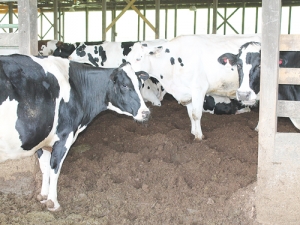Cows can dance for joy or stretch right out in deep, peaceful sleep because of the comfort of compost-bedding pack barns, says Maury Cox of the Kentucky Dairy Development Council.
Many barn systems in the US use a compost-type bedding, and in Kentucky they are busy trying to perfect their “compost bedded pack barn”, which particularly suits family-type operations.
Dairy News visited, with an Alltech Rebelation Symposium tour, the farm of Bill Mattingly, near Lexington, Kentucky, where a compost bedded pack barn was installed recently for their 200-cow family operation.
Their compost bedded pack barn is simply based on sawdust flooring which, when mixed with the effluent and managed well, including frequent turning, becomes a crumbly dry compost. The cows are comfortable on the compost which can eventually be used for fertiliser.
Cox says they started this about eight years ago in Kentucky when they realised they had plenty of sawdust for the barns. But the key is to manage it well – and that means plenty of stirring. “You have to aerate it so it will make compost,” he says.
The Mattingly farm stirs it twice a day both ways when the cows come out. “You notice that if it starts to get a bit moist or wet and sticks to the cows, you need to add some bedding such as sawdust,” Cox explains. “We have seen that if it is managed correctly there is a lower instance of mastitis, and we have seen an increase in production…. We are seeing cows lasting longer, performing and being a lot more comfortable.”
The compost bedded pack barn methods have been the subject of university studies. They thought the heat produced by the compost would kill bacteria but that is not necessarily happening; there is still quite a lot of bacteria in the compost. “But if the cows are comfortable, well-kept and treated properly – cleaned during the prep time for milking, and post dipped – we see a lower incidence, in most cases, of mastitis or somatic cell count levels.
“But if you get it too wet it’s going to blow up and be ugly. So managing it is very important.”
Huge fans keep the air circulating, and the barn also needs to be well positioned for ventilation.
The compost is good underfoot for the cows. If it composts well, the bulk reduces. It may have to be changed every six months but he has seen some farmers with good systems carry on for two or three years “if it’s working right. But if it was not working completely right you would have to bring it out once or perhaps twice a year. For most folks it’s once a year.”
Kentucky used to operate mainly on old stack barns. A layer of straw would be put down, then when it got “nasty” you’d put another layer down. The key with the compost barn is the stirring. To stir it they use a rotor-tiller or a special cultivator. It has prongs like a regular cultivator and it gets down about 4-5cm. Sometimes the compost is so warm steam rises up as they stir it.
The system started in Minnesota but they find the Kentucky climate better suited. Israel also uses the technique with a lot more aeration and sometimes can go a year without adding bedding, says Cox.
A great thing about the compost bedded pack barn is it eliminates liquids so there’s no runoff, he says. You can clean it out quickly, use it as compost on your own farm and haul it to a distant field quite easily. He says some farms get a big milk production boost because the cows are so comfortable.


















